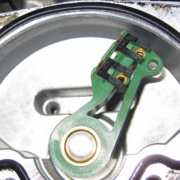NAPA Know How: What Is a Throttle Position Sensor?NAPA Know How Blog
[ad_1]
What is a throttle position sensor, and why is it important for it to work correctly? The throttle position sensor (TPS) is an essential part of your vehicle’s fuel management system, tasked with ensuring that a precise blend of air and fuel is routed to your engine. This sensor works in tandem with others sensors to optimize acceleration, cruising speed and fuel economy. Replacing a defective TPS is critical for keeping your vehicle running smoothly. But, exactly what is a throttle position sensor, and how can you recognize when one might be faulty?
TPS Trouble
Manufacturers typically place the throttle position sensor on the throttle valve spindle to monitor its position. The engine control unit (ECU) collects TPS data to optimize vehicle performance.
A faulty throttle position sensor doesn’t happen without warning. Some of the telltale signs include:
- The panel light activates. Once a TPS goes rogue, the ECU displays a warning on the instrument panel. A diagnostic tool will help you determine what the check engine light is signaling.
- Your car shakes and quakes. A faulty TPS can cause your car to shake like it has engine knock.
- The acceleration is unresponsive. Press the pedal to the metal and you should receive an instantaneous response. But not so when the TPS is bad or failing. This doesn’t mean your vehicle won’t move forward, however. Indeed, the ECU may activate a “limp home” mode, which makes it possible to get the vehicle out of traffic and over to the side of the road.
- The engine stalls or surges. Instead of outright failure, the TPS may cause the engine to stall or surge as the sensor attempts to send the right mixture of fuel and air.
- The fuel economy nosedives. Sometimes, before the TPS exhibits other signs of trouble, you’ll notice that your car’s fuel economy has taken a direct hit. Specifically, your vehicle will consume more fuel as the engine works harder to compensate for a faulty TPS.
TPS Solution
Once you diagnose the problem, the solution is straightforward: Replace the throttle position sensor. Luckily, this is a job you can handle on your own.
After locating the TPS, disconnect the negative battery terminal before you remove the sensor electrical connector. Next, use a screwdriver to remove the sensor mounting screws, then lift the sensor. Swap out the old sensor with a new one, then reverse the earlier steps. You may need to adjust the sensor screws using a voltmeter to achieve an optimal reading.
TPS Takeaway
When the throttle position sensor is doing its job, your vehicle should accelerate smoothly and maintain its optimal fuel economy. But when it fails, it becomes a safety issue — a problem you must address at once.
Check out all the fuel and emissions products available on NAPA Online or trust one of our 17,000 NAPA AutoCare locations for routine maintenance and repairs. For more information on throttle position sensors, chat with a knowledgeable expert at your local NAPA AUTO PARTS store.
Photo courtesy of Wikimedia Commons.











